Creating delicious, safe, and high-quality BBQ jerky at home is accessible for beginners. Key steps include choosing lean cuts of beef or venison, marinating in a blend of sauces, spices, and liquids, slicing thinly, hanging to dry, and gradually intensifying heat. A simple spice rub of salt, pepper, garlic powder, paprika, and smoked paprika can be used for seasoning. Beginners should focus on consistent texture, using dehydrators for even drying at low temperatures. Safety is paramount—proper cleaning, sourcing fresh meat, and adhering to recommended drying times are crucial. Store finished jerky in airtight containers or freezer bags for freshness and extended shelf life. Creative seasoning blends elevate the DIY experience, making it a sure delight for friends and family.
Looking to craft delicious, homemade BBQ jerky? This comprehensive guide offers a simple recipe perfect for beginners. We’ll walk you through everything from understanding the basics of BBQ jerky to choosing the right meat and seasoning techniques. Learn about dry-curing processes, safe preparation methods, and cooking techniques using an oven or dehydrator. Plus, discover creative variations and storage tips for your perfectly prepared BBQ jerky.
- Understanding BBQ Jerky: The Basics
- Selecting the Right Meat for Homemade Jerky
- Dry-Curing: A Step-by-Step Process
- Seasonings and Marinades: Elevating Your Flavor Profile
- Tips for a Consistent Texture
- Cooking Techniques: Oven vs. Dehydrator
- Safety Precautions for Homemade Jerky
- Creative Variations and Storage Ideas
Understanding BBQ Jerky: The Basics
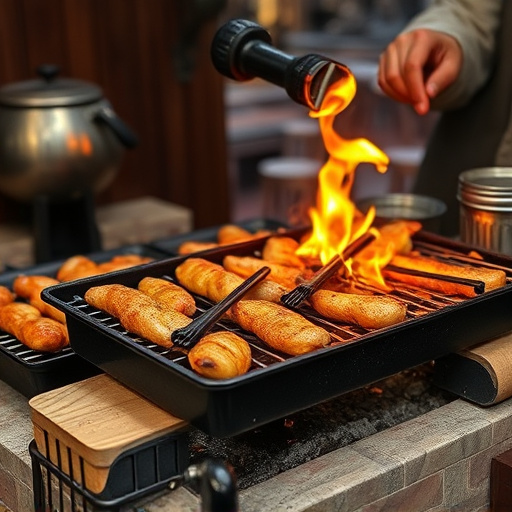
BBQ jerky is a delicious, portable protein snack that’s easy to make at home with the right recipe. For beginners, understanding the basics is key to achieving perfect results. It starts with selecting high-quality, lean meat such as beef or venison. This ensures your jerky turns out tender and flavorful rather than tough and chewy. The next step involves marinating the meat in a combination of spices, sauces, and liquids that penetrate the meat’s fibers, adding flavor and tenderness. Common ingredients include soy sauce, Worcestershire sauce, garlic, and various spices like paprika, black pepper, and red pepper flakes.
After marinating, the meat is sliced thin, ensuring even cooking and fast cooling for safety. Then, it’s hung up to dry, allowing bacteria to be removed through a process called denaturation. This step is crucial in making your jerky last longer without spoiling. During drying, the heat gradually intensifies, causing the moisture in the meat to evaporate, resulting in a lean, meaty snack that retains all the flavors from the marinade. With these simple steps and the right BBQ jerky recipe, beginners can easily create a delicious homemade treat that’s perfect for snacking on any time of day.
Selecting the Right Meat for Homemade Jerky
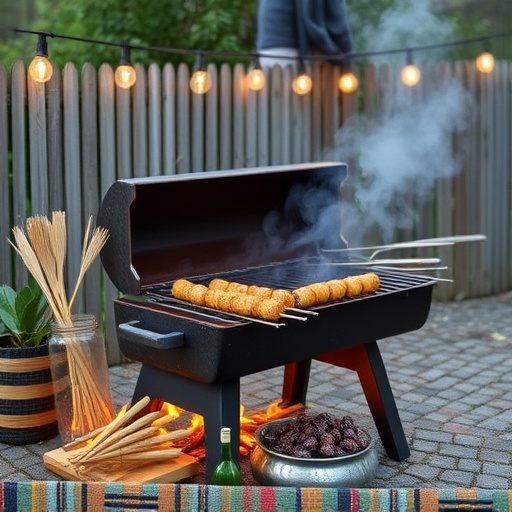
When it comes to crafting your very own BBQ jerky at home, choosing the right meat is a crucial first step. Opting for lean, high-quality protein is key; this could be beef, pork, or even game meats like venison or deer. These cuts of meat will ensure your jerky turns out tender and not too fatty. Lean protein sources tend to dry out more evenly during the dehydration process, resulting in a satisfyingly crisp texture that’s characteristic of great BBQ jerky recipes.
For beginners, sticking to simple, readily available options like flank steak or chicken breast is advisable. These cuts are relatively inexpensive and easy to work with. Plus, they offer a chance to experiment with different marinades and seasonings before settling on your signature blend. Remember, the right meat selection forms the foundation of your BBQ jerky recipe, setting the stage for a delicious homemade treat.
Dry-Curing: A Step-by-Step Process
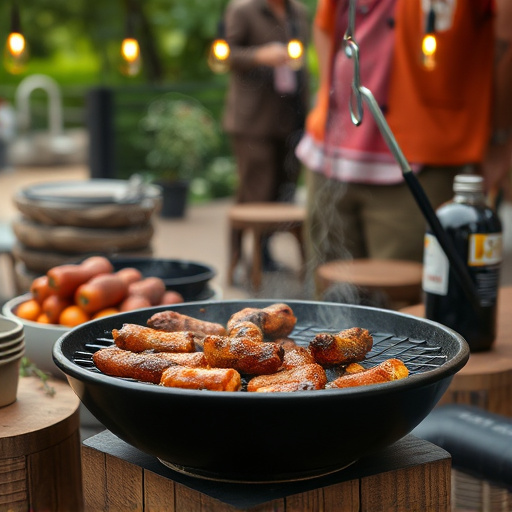
Dry-curing is a traditional method used in crafting delicious homemade BBQ jerky, perfect for beginners looking to master this art. It involves preserving and seasoning meat through exposure to air-drying, salt, and various spices. This process not only enhances the flavor but also helps tenderize the meat, making it an ideal choice for jerky enthusiasts. Here’s a simple step-by-step guide:
1. Start with high-quality, lean cuts of meat like beef or venison. Cut the meat into thin slices, ensuring even thickness to ensure consistent drying.
2. In a non-reactive container (like a glass or ceramic bowl), combine your preferred spice rub. A classic blend includes salt, pepper, garlic powder, and paprika. You can also add smoked paprika for that extra smoky flavor.
3. Place the meat slices in the container, ensuring they are fully submerged in the spice mix. Use your hands to gently press down, helping the flavors penetrate the meat.
4. Cover the container and refrigerate for 2-3 days, flipping the slices daily to ensure even curing. The time may vary depending on the thickness of your cuts and personal preference.
Seasonings and Marinades: Elevating Your Flavor Profile
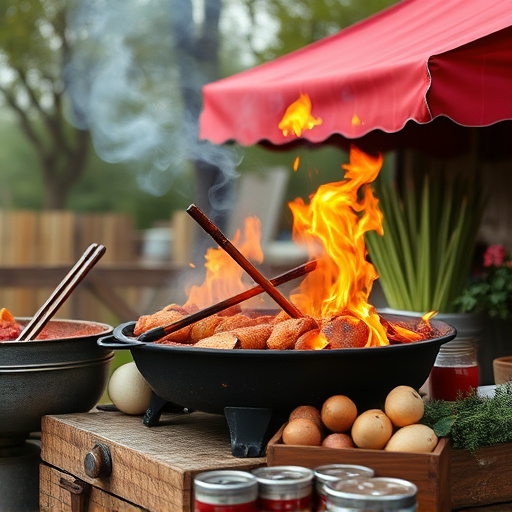
Seasonings and marinades are key elements in crafting a mouthwatering BBQ jerky recipe, allowing beginners to elevate their flavor profile far beyond basic salt and pepper. The right blend of spices can transform simple beef strips into a complex symphony of tastes. Think beyond traditional BBQ rubs; experiment with combinations like garlic and paprika for a smoky, savory kick, or opt for a sweet and spicy mix with chili powder and brown sugar.
For an even more immersive experience, marinades offer an opportunity to infuse moisture and deep flavors into the jerky. A simple mixture of soy sauce, vinegar, and olive oil can work wonders, while apple cider vinegar and honey create a tangy-sweet marinade that tenderizes the meat and adds a delightful glaze. These techniques ensure your BBQ jerky recipe not only tastes amazing but also provides a textural contrast that makes each bite unforgettable—a true testament to the power of seasonings and marinades in homemade jerky creation.
Tips for a Consistent Texture
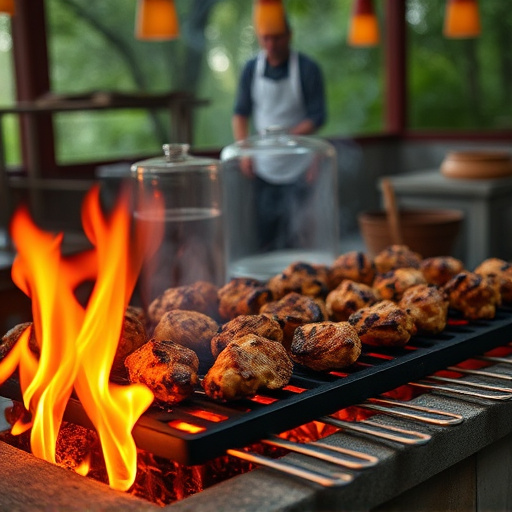
Achieving a consistent texture in homemade BBQ jerky is key to satisfying results, especially for beginners. The first step is to select the right cut of meat; look for lean cuts like sirloin or round steak, as they tend to render well during the drying process, resulting in a tender and uniform texture.
Marination is another crucial aspect. A good BBQ jerky recipe should call for a simple blend of salt, pepper, garlic powder, and paprika for flavor. Letting the meat marinate for 24-48 hours ensures penetration of these flavors throughout the muscle fibers, contributing to a more consistent texture as it dries. During the drying process, whether you’re using a dehydrator or your oven on a low setting, maintain a steady temperature to prevent uneven drying, which can lead to tough patches in the jerky. Regularly checking and flipping the meat ensures even dehydration, resulting in a consistently tender BBQ jerky recipe delight.
Cooking Techniques: Oven vs. Dehydrator
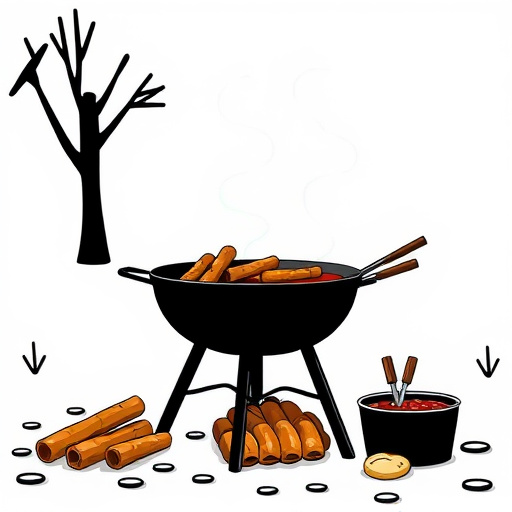
When it comes to making homemade BBQ jerky, deciding between using an oven or a dehydrator is a common question for beginners. Both methods have their advantages and are effective in creating delicious, long-lasting jerky. However, for novice chefs, a dehydrator offers several benefits that can simplify the process.
Dehydrators provide consistent, low-temperature drying, which is ideal for maintaining the meat’s texture and flavor. This method allows you to create jerky with a more even consistency without overcooking or burning the meat. In contrast, ovens require higher temperatures and more hands-on attention, potentially leading to uneven results if not carefully monitored. Using a dehydrator can be a game-changer for BBQ jerky beginners, ensuring they achieve that perfect balance of tender meat and robust BBQ flavors in their homemade jerky recipes.
Safety Precautions for Homemade Jerky
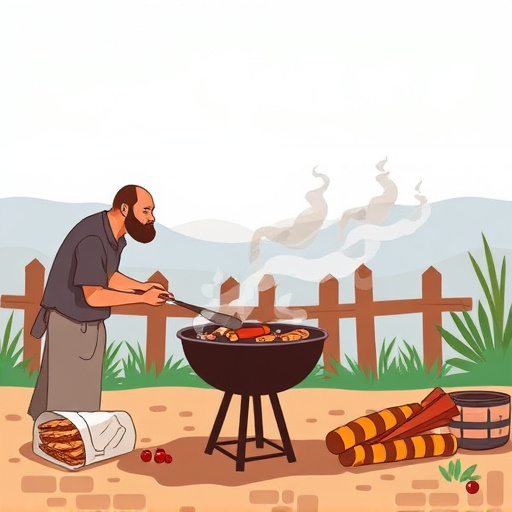
When making homemade BBQ jerky, safety should be your top priority. Always ensure that all equipment and surfaces are clean to prevent cross-contamination from bacteria like E. coli or Salmonella. Use only fresh, high-quality meat sourced from reputable suppliers. The key to safe jerky preparation is proper food handling and low-temperature cooking. Avoid overcooking the meat, as it can lead to a tough texture and potential nutrient loss. Stick to recommended drying times; this ensures that any harmful bacteria are destroyed without compromising the jerky’s quality.
Moreover, store your homemade jerky properly. Once cooled and completely dry, transfer the jerky to airtight containers or freezer bags. Store in a cool, dry place or freeze for long-term preservation. This practice maintains the jerky’s freshness, flavor, and safety, allowing you to enjoy delicious, DIY BBQ jerky without any risks. Remember, following these simple precautions ensures that your homemade BBQ jerky recipe turns out not only tasty but also safe to consume.
Creative Variations and Storage Ideas

Add a creative twist to your homemade BBQ jerky by experimenting with different seasonings and ingredients. You can go beyond the classic BBQ rub and try combinations like teriyaki, chili lime, or even honey garlic. For a unique flavor profile, consider adding spices such as cumin, paprika, or cayenne pepper for a kick. Don’t be afraid to get creative—mixing and matching flavors will result in delicious, personalized jerky that’s sure to impress your friends and family.
When it comes to storing your freshly made BBQ jerky, proper preservation is key. After all your hard work, you’ll want to keep it tasty for as long as possible. A great option is to store the jerky in airtight containers or vacuum-sealed bags in the refrigerator. This helps maintain freshness and prevents the jerky from drying out. For longer-term storage, consider freezing your jerky in smaller portions—this ensures you always have some on hand when a BBQ craving strikes!
